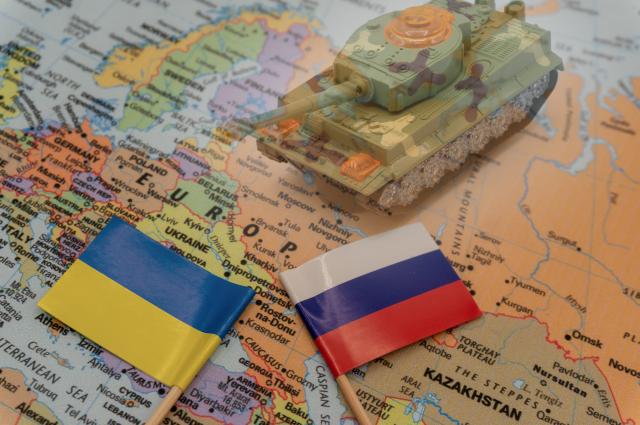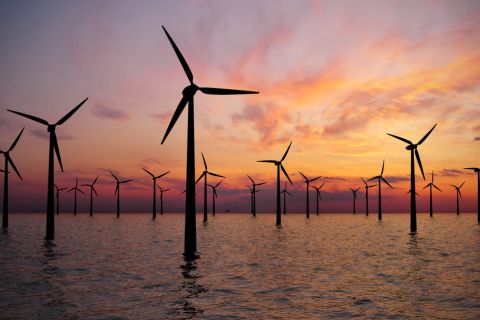
Ukrainian and Russian flags placed on a map of Europe. (Source: Shutterstock.com)
The Russian Kremlin’s coffers continue to feel the pinch under the strain of western sanctions and lower oil prices exactly one year on from its decision to invade Ukraine.
“Russia’s fiscal revenues from oil operations plunged 48% year-over-year in January to 310 billion roubles [$4.2 billion], while export revenues dropped 36% to $13 billion,” the International Energy Agency (IEA) revealed in its Oil Market Report in February.
Moscow’s aim to reduce oil production in March could be a move to shore up oil prices, the IEA said as Russia sold its exports at a large discount in January. While Russia’s 2023 budget is based on a urals price of $70.10/bbl, its export price averaged $49.48/bbl in January compared to a North Sea dated price of $82/bbl.
RELATED
Russian ‘Ghost Tankers’ Stalk Global Oil Markets
Sanctions on Russia, coupled with the country’s mandate to reduce Russian energy exports to certain countries, have led to an energy crisis in the U.K. and Europe in particular, which have turned increasingly to U.S. LNG imports to fill the gap left by absent Russian molecules.
“Economically, the Kremlin's weaponization of natural gas exports and threats to do the same vis-à-vis oil are highlighting the urgency of energy security,” Raymond James wrote Feb. 14 in a research report. “Russia is cushioned by the resilience of its trading relationships with China, India and some other emerging markets, as well as the Kremlin’s other economic counter-strategies.”
RELATED
TotalEnergies CEO Says $100/bbl Could Come Back
There are long-term consistent interests as to why Putin would invade Ukraine, Dr. Thomas Wilfred O’Donnell, a global fellow at the Woodrow Wilson Center in Washington and an instructor at Freie Universität Berlin, told Hart Energy during a phone call from Germany.
“There's frankly no way Russia can be a superpower without Ukraine, Georgia and Belarus,” said O’Donnell, an expert analyst and writer working on energy and international affairs, referring to Putin’s decision to invade Ukraine.
Oil supply set to exceed demand
Oil prices have finally returned to pre-war levels with the exception of diesel, according to the IEA. World oil supply is expected to exceed demand in the first half of 2023, although the second half of the year has potential to change to a deficit as demand recovers and some Russian output is shut in.
Despite efforts to the contrary, Russia has maintained oil production and exports by rerouting shipments to Asia, and the “G7 price cap on crude appears to be helping to keep the barrels flowing,” the IEA said.
For its part, Russia produced 9.77 MMbbl/d in January 2023 compared to 9.81 MMbbl/d in December 2022, down 160,000 bbl/d from pre-war levels. Importantly, 8.2 MMbbl/d was shipped to international markets in January.
“But in a sign that Moscow may be struggling to place all of its barrels, Deputy Prime Minister Alexander Novak said in early February that Russia would curb output by 500,000 bbl/d in March rather than sell to countries that comply with the G7 price caps,” the IEA said.
Russian gas flows and revenues are important but take a back seat to oil which is Putin’s main revenue source, O’Donnell said.
“Right now we really don't have a market for this oil in the rest of the world amid this recession… and you’re not going to stop the war directly, but [sanctions are] making [Putin’s] life difficult,” O’Donnell said. “And the new infrastructure to sell that gas to China and being totally dependent on China is not exactly a very pretty picture for Russia.”
Recommended Reading
First US Utility-scale Offshore Wind Farm Starts Operations
2024-03-14 - The 12-turbine, 130-megawatt South Fork Wind project is a joint venture between Denmark's Orsted and New England-based electric utility Eversource.
Equinor, Ørsted/Eversource Land New York Offshore Wind Awards
2024-02-29 - RWE Renewables and National Grid’s Community Offshore Wind 2 project was waitlisted and may be considered for award and contract negotiations later, NYSERDA says.
Eversource to Sell Sunrise Wind Stake to Ørsted
2024-04-19 - Eversource Energy said it will provide service to Ørsted and remain contracted to lead the onshore construction of Sunrise following the closing of the transaction.
Equinor, Ørsted Bid for Better Contract in NY Offshore Wind Auction
2024-01-26 - New York State has received bids to supply power from three offshore wind projects in its expedited fourth solicitation that allowed developers to exit old contracts and re-offer projects at higher prices.
Dominion Energy Receives Final Approvals for 2.6-GW Offshore Wind Project
2024-01-30 - Dominion Energy’s Coastal Virginia Offshore Wind project will feature 176 turbines and three offshore substations on a nearly 113,000-acre lease area off Virginia Beach.




